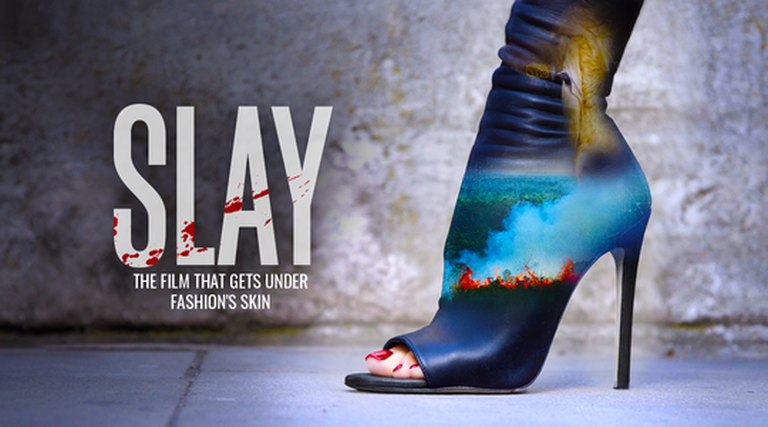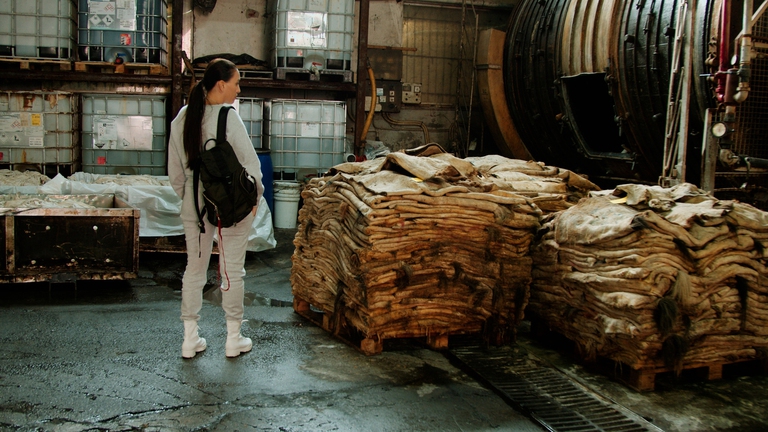https://www.lifegate.it/materiali-animali-moda-2
- |
The documentary “Slay” will be screened in Milan at the Anteo cinema on 14 June 2023 as a special event within the ninth edition of the Milan Fashion Film Festival, in the presence of fashion school students and journalists.Following this, a panel discussion will be held with Emma Hakansson, co-author of the film as well as activist and founder of Collective Fashion Justice and member of the 2023 jury of the Fashion Film Festival Milano.
- Even when we talk about sustainable fashion, animal rights are rarely discussed.In addition to furs and exotic skins - now condemned by most - there are many animal derivatives that we wear every day, above all leather and wool, but also silk, feathers, cashmere.
- The documentary Slay by French director Rebecca Cappelli - which can be viewed for free online - addresses this issue by trying to dispel some false myths and talking about the alternatives now available.
- Slay shows an opaque and poorly regulated supply chain that, from China to Tuscany to Australia, supplies a fashion system based on frenetic consumption and overproduction.
What we wear is no longer just an expression of our personality:it has become the mirror of the values we believe in.Just like what we eat.Yet, if it is true that the discussion on the uselessness of animal suffering in nutrition it is now cleared through customs, even for family lunches, but it is not as regards the fashion industry.Social sensitivity has certainly changed regarding the topic of fur - so much so many brands have become fur free – and partly also with respect to the use of exotic skins, but not with regard to all other animal derivatives, from leather to wool and silk.Indeed, it is a topic that often remains in the background even when talking about ethical and sustainable fashion.
Why do we use animal derivatives?
The documentary Slay by the French director Rebecca Cappelli it is, in this sense, a turning point.Well constructed, raw without being excessive (the director wanted the widest possible audience to see it), it asks a very specific question:why we use animal derivatives in fashion since we have some alternatives?
The answer is certainly complex and Cappelli searched for it in a long process that cost her three and a half years of research and a trip around the world, in which she put herself personally at stake.“I grew up in Paris, I love fashion.Slay is my personal journey as a fashion consumer.I loved wearing luxury accessories in leather, cashmere and even fur.At the same time, I considered myself a person who loved animals, one of those who helped save them.Putting myself inside the film made me vulnerable and took me out of my comfort zone, but it was essential", says the director after the Italian premiere of the film, screened in Milan.The documentary, by choice of the director and producers, can be viewed for free online at WaterBear, a free streaming platform for films with ethical and environmental content.

From China to Tuscany to India
Slay (from the English verb “to kill”) focuses on three specific areas – fur, leather and wool – and tries to dismantle the clichés that revolve around these materials and to make clear thenegative impact that they have not only on the animals themselves, but also onenvironmental pollution, on the loss of biodiversity, on the workers involved in the supply chain.
“Slay doesn't have a starting script, everything is filmed on location for the first time without inspections.I chose not to include the crudest scenes we found ourselves in front of, such as the flaying or killing of an animal, because, honestly, they are something unwatchable", continues the director.
From the China, where Cappelli investigates the world of furs and terrible farms, in Santa Croce sull'Arno in Tuscany, where the theme of leather tanneries is addressed, the common thread that holds the scenes together is the general sense of illegality and lack of controls and transparency of the supply chain.In Haining, an hour from Shanghai, Cappelli finds it easy to buy furs of protected species, while in Tuscany the conditions of foreign tannery workers do not appear all that different from those filmed in Kanpur, in India, the global producer city of low-cost leather, where the population suffers from various diseases due to the chemical elements used to treat the skins and then discharged into rivers and land.

Cappelli reserves the central part of Slay for the theme of leather and accompanies it with data and research collected together with Collective fashion justice, a non-profit organization that promotes ethical and fair fashion for the planet, animals and people.The cliché he tries to dispel is that the leather used in fashion is a by-product of the food industry and which, therefore, if it were not exploited in this way would still be a waste element.
In reality, these are two sides of the same coin.The leather itself is itself a commodity for which animals are raised and killed, a product market valued in 394 billion dollars (in 2020).In addition to animal suffering, the issue therefore concerns deforestation to make room for livestock farming, primarily in the Amazon, and the conditions of workers, both in slaughterhouses and tanneries.
It is estimated that the production of one pair of cowhide boots produces 66 kilos of CO2 and uses 12,370 liters of water.In comparison, it is shown that the alternatives to leather now available, both synthetic and so-called bio-based, i.e. derived from vegetables, have a lower impact in terms of emissions and water footprint.This is a point that Rebecca Cappelli wants to address seriously, because it is often from here that the debate on what is more sustainable begins.For this reason, an is made available on the Slay website mini book with data and research to delve deeper into the issue.
We need to question what we wear
For a non-vegan viewer and not connected to the world of animal rights activism, perhaps the most surprising part of Slay is the one dedicated to wool.A material so widespread in the framework of overproduction of fashion which necessarily relies on a system of intensive farming, far from the bucolic idea of free and happy sheep on the meadows.“I know the public is often surprised about wool.Certainly there are tiny farms with few animals that are treated well, but this is not the case with the vast majority of woolen items we wear.Sheep and lambs are considered a commodity:when they start to cost more than the value of what they produce, they are killed, even if they are young and healthy,” concludes Cappelli.

The power of a film like Slay is to spark conversation around a little-discussed topic.Only a few years ago it seemed impossible to give up fur, while today the prospect ofEurope without fur farms it is real and ever closer, and it seems reasonable even to those who are not particularly attentive to animal rights (the campaign Fur free europe also promoted by Slay, it reached over 1 million 700 thousand signatures from European citizens).
As in the food supply chain, also in the fashion supply chain, the final consumer now has lost the connection with the origin of what he purchases, which he then eats or wears, and the world of global markets has contributed to loosening the perception of this bond and the origin of things even further.The leather of shoes and the wool of sweaters used to be on a living being.Slay comes back to remind us.
